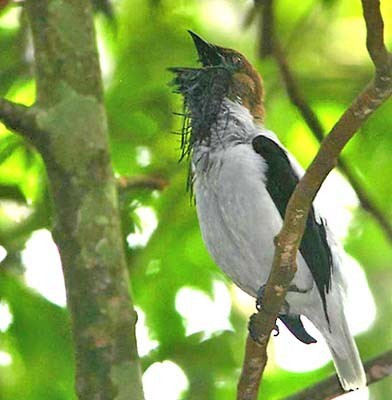Bearded Bellbird
A species of Neotropical Bellbirds Scientific name : Procnias averano Genus : Neotropical Bellbirds
Bearded Bellbird, A species of Neotropical Bellbirds
Botanical name: Procnias averano
Genus: Neotropical Bellbirds
Content
Description General Info
 Photo By Don Roberson
Photo By Don Roberson Description
Like other cotingas, the bearded bellbird has a broad hooked-tipped bill, rounded wings, strong legs and a striking appearance. The male is approx 28 cm 11 in long, and weighs 180 g (6 ⁄2 oz). His plumage is white or greyish-white apart from the black wings and warm brown head. He sports a grotesque "beard" of un-feathered, black stringy wattles. The female is smaller, at approx. 27 cm (10 ⁄2 in) and 130 g (4 ⁄2 oz). Her upperparts are olive-green (duskier on the head), most of the underparts are yellow streaked with green, and the vent is pure yellow. She lacks the facial wattles ("beard"). Both sexes have dark eyes, a black bill and grey to black legs. The males' advertising calls are a very loud dull Bock repeated every few seconds and a somewhat less loud, metallic hammering tonk-tonk-tonk-tonk. It sounds like a hammer rapidly hitting an anvil and is repeated 20-30 times. Additionally, a number of regional calls are known, e.g. an unmusical, almost hissing, bisset in southern Venezuela and a disyllabic teek-terong in northern Venezuela. Apparently, the last mentioned call is no longer heard in Trinidad. The female is essentially silent. 
Size
28 cm
Nest Placement
Tree
Habitat
The habitat of bearded Bellbird predominantly comprises humid evergreen lowland forests and the lower strata of humid montane forests, including adjacent areas with tall secondary growth. In certain broader geographical regions, bearded Bellbird is also found in drier deciduous forests, as well as in regions characterized by tall caatinga and cerradão vegetation.
Dite type
Frugivorous
General Info
Feeding Habits
Bird food type

Fruit
Distribution Area
The bearded bellbird is native to Venezuela (as well as adjacent parts of Colombia and Guyana), Trinidad and Tobago and northeastern Brazil, where it occurs in humid forests and woodland. It is mainly resident, but some populations take part in altitudinal migrations; breeding at altitudes of up to 1,900 m (6,200 ft) and spending the non-breeding season in the lowlands. There are two subspecies; the nominate taxon, P. a. averano, in northeastern Brazil and P. a. carnobarba in Venezuela, Trinidad, extreme northeastern Colombia, western Guyana and far northern Brazil. It is a localised and uncommon bird in Venezuela, but is fairly common in Trinidad. The nominate Brazilian race is relatively rare due to extensive habitat destruction in its range and heavy trapping for the cagebird trade, and as such is considered "vulnerable" by Brazilian environmental authority (IBAMA). 

 Photo By Don Roberson
Photo By Don Roberson Scientific Classification
Phylum
Chordates Class
Birds Order
Perching birds Family
Cotingas Genus
Neotropical Bellbirds Species
Bearded Bellbird